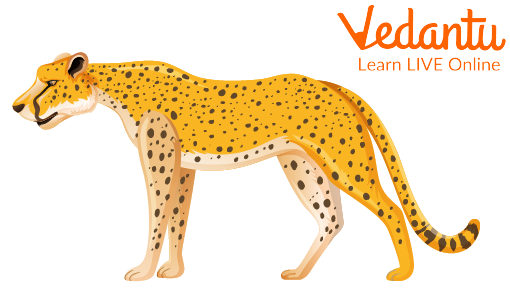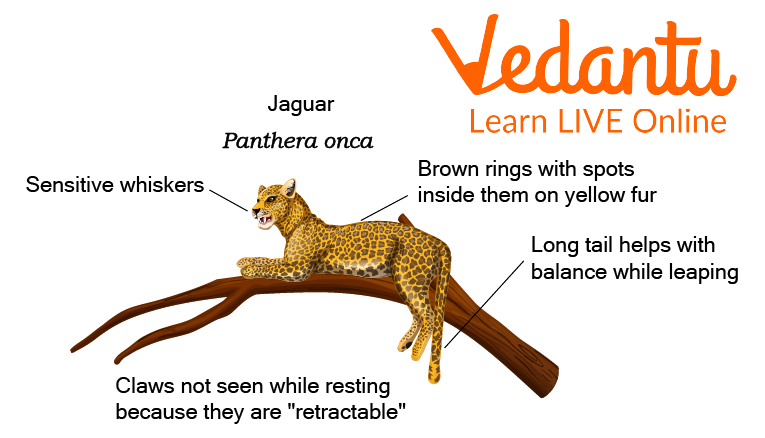




Introduction to Jaguars
Kids, do you know what wild animals are? Wild animals are those animals that cannot be domesticated or kept as pets. They roam freely in the jungle and hunt other animals to survive.

The Magnificent Jaguar
Jaguar comes from the word “yaguar”, meaning “he who kills with one leap”. They are the third biggest cat in the world, right after tiger and lion, and the biggest cats in America. Jaguars can be located in North, South, and Central America. They are also the only living member of the Panthera native to America.
There is a black form of the Jaguar as well. It has black ground colour with black spots called the Black Panther. This sub-species of jaguar can be found more commonly in Asia than in other parts.
Physical Features of Jaguars
Being the majestic animals that they are, let's throw some light on the physical features of jaguars:
Jaguars have an exceptionally swift and agile bodies.
Their coats help them camouflage in their surroundings.
Every jaguar coat has a different and unique pattern to be individually identified.
Their tail itself measures 80 cm, excluding their length.
Even though they can make big leaps almost 10 feet high, jaguars have short legs.
Their heads are round and large.
Their tongues have sharp-pointed bumps known as papillae, which help them to scrape the meat from their prey.
They have teeth so strong that they can easily take down preys that are even 3-4 times their weight.
Habitat
Where do you think jaguars like to live? We often find a jaguar near a low-lying tropical habitat closer to lakes, rivers, and inland wetlands.
Before losing their land to habitat loss, Jaguars could be located in the Southwestern part of the USA to the grasslands of Argentina. But currently, their movement is restricted to the rainforests of the Amazon.
Brazil takes pride in having almost 50% of the jaguars alone. The remaining 50% are divided into 8 countries that share the Amazon forest: Peru, Bolivia, Ecuador, Colombia, Guyana, Venezuela, Suriname, and French Guiana.
What Do Jaguars Eat?
As we know, Jaguars are carnivorous mammals, and their diet is rich in meat and fish. Jaguars are not only good swimmers, but they are very good climbers as well. Therefore, they can eat anything and everything they can prey upon or whatever crosses their way, like deer, tortoises, iguanas, fish, birds, and even monkeys.

Jaguar Family
Interesting Facts About Jaguars
Though there are many things to know and discover about wolves, let us begin with some interesting facts about wolves:

Features of Jaguar
Some Facts About Jaguars
Now that we have gathered some basic information on jaguars, let us learn some more facts about jaguars.
Jaguars are known for being loners. They like to live alone.
But Jaguars are territorial animals, meaning they mark or define their territory by clawing trees or with their waste.
Female jaguars can give birth to 1 - 4 cubs at one time.
At birth, the cubs depend on their mother as they are born blind. For almost 2 years, the mother stays with the cubs, protects them from predators, and teaches them to hunt.
Fun Facts for Kids
Now that we have collected some facts about jaguars, let's share some interesting, fun facts for kids:
Jaguars constitute the largest cat in America.
Jaguar;’s regular call is called a “saw” because their call sounds like a sawing of wood.
Do you know what jaguars do when they greet each other? They make a noise like a nasally snuffling.
Can you believe that the jaguar's jaw is so powerful that its one bite exerts more force than a lion's?
It is astounding that jaguars are nocturnal, which means they can hunt both during the day and at night.
Jaguars are quite excellent at swimming, just like tigers and enjoy their time in the water. They are so confident swimmers that they can cross large rivers.
You will be amazed that Jaguars stalk their prey and then ambush them.
They either leap into the water or from a tree to ambush their prey.
They can easily bite through the shell of turtles because of their strong teeth.
Summary
Even thorough Jaguars are known as savage predators and have quite an important role in controlling the population and helping maintain a balance in the food chain. I know it might be quite hard to believe, but in many South American cultures, these powerful cats were worshipped as gods.
We hope you enjoy reading this article. Protecting the jaguars and their habitat is essential as it will also help the other wildfires. In case of any other doubts, feel free to ask in the comments.
FAQs on Interesting Facts About Jaguars
1. Are there any threats to jaguars in terms of their survival?
As we all are aware that in South America, deforestation rates are on the rise, therefore, leading to threats to the survival of jaguars and many other animals. It has resulted in the loss of their homes and made breeding harder for them as their population has become isolated. And, of course, they are also hunted illegally for their skin.
2. Are there different species of Jaguars?
Jaguars have only one species, and there are no different types of jaguars, and they don’t have any different scientific names. However there are four specific regional types of jaguars, but the difference is only geographical.
3. Is there any difference between a leopard and a jaguar?
Even though Jaguars are regularly mistaken for leopards. An inexperienced eye can easily make this mistake, but if you look closely, jaguars have circular markings, also known as rosettes. One can find black dots in their rosettes. Whereas in leopards, there is no such thing. And as mentioned earlier, jaguars, as compared to leopards, have rounded, larger heads and short legs.









